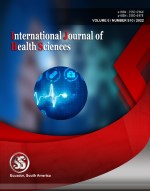Frequency of giardia lamblia infection in children presented with acute diarrhea to tertiary care hospital
Keywords:
frequency, giardia lamblia infection, childrenAbstract
Background: Giardia lamblia was the most common parasite-caused gastrointestinal ailment in the United States by the late 1980s, and it is now a significant global public health issue. Giardiasis is an infectious condition that may have both short-term and long-term effects. Objective: To assess the frequency of giardia lamblia infection in children presented with acute diarrhea to tertiary care hospital. Methodology: The current Descriptive Cross Sectional study was carried out at the Department of Paediatrics, Hayatabad Medical Complex, Peshawar from 21 July, 2019 to 22 January, 2020. The overall Sample Size in the current study was 114. After performing the stool concentration technique using the formol-ether concentration method, trophozoites and cysts of Giardia lamblia were detected using direct microscopy of the smear in saline (0.90% w/v NaCl solution) and Lugols iodine. Data was entered in SPSS version 23.0. Results: In the current study, totally 114 patients were enrolled. Mean and SDs for age was 4.13+1.566. Mean and SDs for weight was 13.21+2.598. Mean and SDs for BMI was 24.93+0.890. Mean and SDs for duration of disease was 7.02+1.540. 43 (37.7%) patients were females and 71 (62.3%) patients were males.
Downloads
References
Jethwa DK, Chaudhri U, Chauhan D. Prevalence of giardia infection in paediatric age group. Int J Curr Microbiol App Sci 2015;4(8):907-11.
Luther AB, James AP. Giardia: a pathogen or commensal for children in high prevalence settings? Curr Opin Infect Dis. 2016 Oct;29(5):502–07.
Isaac AB, Charles AN, Dora O. Charles AB. Giardia lamblia infections in children in Ghana. Pan Afr Med J. 2016;24:217.
Teshome F, Fufa A, Mekonnen G. Intestinal protozoal parasites in diarrheal children and associated risk factors at yirgalem hospital, ethiopia: a case-control study. Int Sch Res Notices. 2014;2014:357126.
Jethwa1 DK, Chaudhri U, Chauhan D. Prevalence of giardia infection in paediatric age group. Int J Curr Microbiol App Sci 2015;4(8):907-11.
Tak V, Mirdha BR, Yadav P, Vyas P. Molecular characterisation of Giardia intestinalis assemblages from human isolates at a tertiary care centre of India. Indian J Med Microbiol. 2014;32(1):19-25.
Ryu H, Alum A, Mena KD, Abbaszadegan M. Assessment of the risk of infection by Cryptosporidium and Giardia in non-potable reclaimed water. Water Sci Technol. 2007. 55(1-2):283-90.
Farthing MJ. Giardiasis. Gastroenterol Clin North Am. 1996 Sep. 25(3):493-515.
Sears CL. Giardiasis. Giardiasis. Goldman L, Ausiello D, eds. Cecil Medicine. 23rd ed. Philadelphia, PA: Saunders; 2007. 2402-4.
Monis PT, Thompson RC. Cryptosporidium and Giardia-zoonoses: fact or fiction?. Infect Genet Evol. 2003 Nov. 3(4):233-44.
Huang DB, White AC. An updated review on Cryptosporidium and Giardia. Gastroenterol Clin North Am. 2006 Jun. 35(2):291-314, viii.
Thompson RC, Palmer CS, O'Handley R. The public health and clinical significance of Giardia and Cryptosporidium in domestic animals. Vet J. 2008 Jul. 177(1):18-25.
Ballweber LR, Xiao L, Bowman DD, Kahn G, Cama VA. Giardiasis in dogs and cats: update on epidemiology and public health significance. Trends Parasitol. 2010 Apr. 26(4):180-9.
John CC. Giardiasis and balantidiasis. Kliegman RM, Behrman BE, Jenson HB, Stanton BF, eds. Nelson Textbook of Pediatrics. 18th ed. Philadelphia, PA: Saunders; 2007. 1462-4.
Buret AG. Mechanisms of epithelial dysfunction in giardiasis. Gut. 2007 Mar. 56(3):316-7.
Beer KD, Collier SA, Du F, Gargano JW. Giardiasis diagnosis and treatment practices among commercially insured persons in the United States. Clin Infect Dis. 2017 May 1. 64(9):1244-50.
Eisenstein L, Bodager D, Ginzl D. Outbreak of giardiasis and cryptosporidiosis associated with a neighborhood interactive water fountain--Florida, 2006. J Environ Health. 2008 Oct. 71(3):18-22; quiz 49-50.
Published
How to Cite
Issue
Section
Copyright (c) 2023 International journal of health sciences

This work is licensed under a Creative Commons Attribution-NonCommercial-NoDerivatives 4.0 International License.
Articles published in the International Journal of Health Sciences (IJHS) are available under Creative Commons Attribution Non-Commercial No Derivatives Licence (CC BY-NC-ND 4.0). Authors retain copyright in their work and grant IJHS right of first publication under CC BY-NC-ND 4.0. Users have the right to read, download, copy, distribute, print, search, or link to the full texts of articles in this journal, and to use them for any other lawful purpose.
Articles published in IJHS can be copied, communicated and shared in their published form for non-commercial purposes provided full attribution is given to the author and the journal. Authors are able to enter into separate, additional contractual arrangements for the non-exclusive distribution of the journal's published version of the work (e.g., post it to an institutional repository or publish it in a book), with an acknowledgment of its initial publication in this journal.
This copyright notice applies to articles published in IJHS volumes 4 onwards. Please read about the copyright notices for previous volumes under Journal History.
















